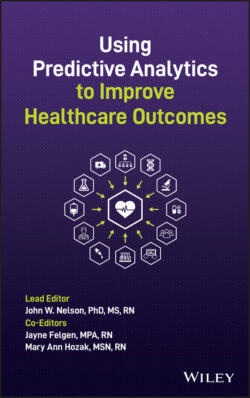Читать книгу Using Predictive Analytics to Improve Healthcare Outcomes - Группа авторов - Страница 73
Leaders Using Data for Inspiration: Story 2
ОглавлениеHere is an example of how a staff‐level leader's enthusiasm for data led to some stellar, long‐lasting outcomes.
A young nurse, in practice for about 3 years, volunteered to be one of the original members of the staff council in an organization implementing Relationship‐Based Care® (Creative Health Care Management, 2017; Koloroutis, 2004). One of the major drivers of her interest was access to the clinical data and the opportunity to improve patient care with full access to outcomes of care. She had never had this sort of access before, and she was very curious about data and its implications for care delivery transformation. Her excitement at the opportunity to hear revealing new data about her unit, firsthand from the data scientist, was a large part of what drew her to take on the leadership responsibility of co‐chairing the staff council. The data was presented and explained in such a way that it motivated her to create enhancements to the professional practice model on her unit while all of the information was fully available to the staff council and unit staff members. She recalls that the availability and transparency of the data led to building relationships among staff members and their manager, and inspired them to build a strong working team.
Her excitement at the opportunity to hear revealing new data about her unit, firsthand from the data scientist, was a large part of what drew her to take on the leadership responsibility of co‐chairing the staff council.
Two major milestones stood out for her. First, she was struck by the power of the Primary Nurse–patient relationships on the unit. During her time co‐chairing the council, this nurse cared for a chronically ill cancer patient who was about her age. As her Primary Nurse, she developed a relationship with this patient and was shocked and humbled when the patient requested—rather insisted—that she have her surgery on a day the Primary Nurse was working. This pattern of the patient coordinating her care with her oncologist and her Primary Nurse continued for months. Over time, patient and nurse worked together to be sure the Primary Nurse was working at the same times the patient came in for treatment. This event represented a milestone in the rollout of the Relationship‐Based Care model. This nurse’s actualization of autonomy as a Primary Nurse became a beacon to all of the staff councils and unit staff members.
This nurse’s actualization of autonomy as a Primary Nurse became a beacon to all of the staff councils and unit staff members.
Secondly, as a co‐chair of the staff council, this nurse engaged in using data to identify barriers to the implementation of Relationship‐Based Care. As staff council members began to recognize patterns in the disruption of patient care, they requested permission from their nurse manager to start a support group for patients and families on their unit. The manager fully supported this idea and gave the nurses one hour per week of protected time in which to conduct a regular support group. The unit social worker, in the role of co‐chair of the Patient‐Family Advisory Council, also supported this effort. An interdisciplinary team met weekly with patients and families to listen to the ways in which the team could make care better for them and other patients. The nurse recalls that practical suggestions emerged from these meetings such as the need to have sandwiches stocked on the floor for patients at night and the need for family members to have more direct access to the Primary Nurse or associate nurse. The meetings produced ideas on which the practice council could take action to implement changes to enhance patient and family satisfaction. The unit‐based Patient‐Family Support Group, created by the staff council, grew to be the model for an institution‐wide Patient‐Family Advisory Council that is still in place today.
